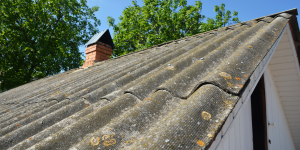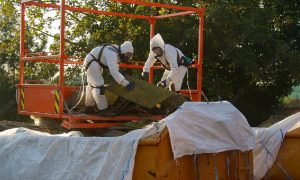What is Asbestos Removal in Australia

Asbestos is a group of natural minerals composed of microscopic fibers. These minerals have been sought after for their exceptional resistance to heat, corrosion, and sound absorption capabilities, resulting in extensive use for many years. These fibers are incredibly durable and do not conduct electricity, properties that led to their widespread use across various industries, particularly in building and construction.
The harmful effects of asbestos have been particularly felt in Australia, where it was widely used for decades in various industries, notably construction and manufacturing. Australia’s fraught relationship with asbestos has left a legacy that continues to impact public health and necessitates stringent safe asbestos removal practices, especially in construction, renovation, and demolition.
In this blog post, we aim to provide a comprehensive understanding of asbestos: its types, its historical use in Australia, the health implications it poses, and how it impacts our work in the demolition industry. We will explore the crucial role of professional demolition companies like ours in safely managing and removing asbestos, ensuring that the health risks it presents are minimally felt in our Australian community.
Historical Background of Asbestos
The Early Uses of Asbestos
As early as 2500 B.C., asbestos was used to fortify fabrics, making them heat-resistant. Its impressive attributes made it a valuable resource across civilizations and industries.
Asbestos in Modern Times
With industrialization, the demand for asbestos grew exponentially due to its unique properties and versatility, resulting in widespread use in the construction, automotive, and shipbuilding industries.
Understanding the Different Forms of Asbestos
Types of Asbestos
Despite its infamous reputation, asbestos is not a singular substance. Still, there are six types if asbestos which are naturally occurring, all sharing the characteristic of being composed of fine, fibrous crystals. Each of these asbestos types has unique properties and uses, contributing to their varied prevalence in the human environment.
1.Chrysotile:
Also known as white asbestos, chrysotile is the most commonly used form worldwide, contributing to about 95% of all asbestos used in the United States. This type of asbestos is generally sourced from serpentine rocks and is known for its flexibility, strength, heat resistance, and insulating properties. These characteristics made it especially popular in manufacturing roofing materials, brake linings, insulation, etc.
2. Crocidolite:
Often referred to as blue asbestos, crocidolite is renowned for having the finest and most delicate fibers among the asbestos types, making it the most harmful when inhaled. Despite its dangerous nature, it was once widely used for insulation and manufacturing spray-on coatings, pipe insulation, and cement products due to its resistance to chemicals and heat.
3.Amosite:
Amosite, or brown asbestos, was the second most commonly used type. Named after the acronym “Asbestos Mines of South Africa,” it was mainly used in cement sheets, plumbing, and electrical insulation. Amosite’s fibers are brittle, straight, and rod-like, with high heat resistance, making them particularly hazardous when disturbed
4. Anthophyllite
This type of asbestos is grey-brown and was not commonly used commercially. Anthophyllite was usually found as a contaminant in composite flooring. While it was less commonly used, exposure to anthophyllite can still lead to mesothelioma and other asbestos-related diseases.
5.Tremolite and Actinolite:
Tremolite and actinolite were not typically used commercially but are often found as contaminants in other asbestos-containing materials. Tremolite fibers are sharp and straight, making them particularly dangerous when inhaled or ingested.
6.Actinolite
Actinolite, a member of the amphibole mineral family, is often associated with its more infamous cousin, asbestos. Both minerals, sharing fibrous properties, were once used in construction due to their impressive tensile strength and resistance to heat. However, unlike the white fibers of asbestos, Actinolite fibers stand out with their characteristic dark hue and glossy sheen.
It’s important to note that all types of asbestos are hazardous to health and can lead to severe conditions such as asbestosis, lung cancer, and mesothelioma. Even limited exposure can cause these conditions, often many years or even decades after the exposure event. As such, any suspected asbestos-containing materials should be handled only by trained professionals following strict safety protocols.
What is asbestos, and why is it popular?
The primary properties that made asbestos popular were its resistance to heat and electricity, chemical stability, flexibility, and the ability to be woven into cloth or mixed with other materials. Its durability made it an economical choice in several industries.
Asbestos and Australia: A Historical Overview
Australia’s Relationship with Asbestos
Australia’s relationship with asbestos is particularly troubling. For decades, it was one of the world’s largest consumers of this harmful material, resulting in severe health consequences for its citizens.
The Growth and Decline of the Asbestos Industry in Australia
The asbestos industry flourished in Australia from the 1930s until the late 1980s, playing a significant role in the country’s construction and manufacturing sectors. Its decline came when the adverse health effects of asbestos became widely recognized.
Asbestos Legislation in Australia
In response to the severe health risks posed by asbestos, Australia has now imposed stringent laws and regulations. These laws cover using, disposing, and removing asbestos, protecting workers and the general public from potential exposure.
Asbestos: The Hidden Health Risk

The Health Impact of Asbestos in Australia
Australia records some of the world’s highest rates of mesothelioma, a deadly cancer caused by asbestos exposure. These statistics are a stark reminder of the legacy of Australia’s extensive use of asbestos.
Long-Term Health Consequences of Asbestos Exposure
Long-term asbestos exposure can lead to severe health conditions, including asbestosis, lung cancer, and mesothelioma. These diseases often appear decades after the exposure, leading to ongoing health concerns for those exposed to asbestos in the past.
Public Awareness and Education on Asbestos in Australia
In Australia, education and awareness campaigns are essential in informing citizens about the dangers of asbestos and the proper safety measures when handling or encountering this hazardous material.
Recognizing Asbestos in Everyday Life
Common Uses of Asbestos
Despite its health hazards, asbestos has numerous uses across industries. Its unique properties make it an ideal material for insulation, fireproofing, and soundproofing in the construction, automotive, and shipping industries.
Occupations at Risk of Asbestos Exposure
Certain jobs, such as construction, renovation, mining, shipbuilding, and manufacturing, are at high risk for asbestos exposure. Workers in these industries must be vigilant and aware of the necessary safety measures.
Identifying What is asbestos: The First Step
Testing for Asbestos
If you suspect your building may contain asbestos, a trained and certified professional should inspect the property. They can take samples for testing in a laboratory, providing a definitive answer on whether the hazardous material is present.
Asbestos Removal: The Critical Role of Demolition Companies
As a professional demolition company, we play a vital role in asbestos removal. We possess the required expertise, equipment, and training to safely remove and dispose of asbestos-containing materials, protecting our team and the broader community.
The Future of Asbestos Management in Australia
As asbestos continues to pose health threats, the need for its effective management and disposal remains a significant concern. Demolition companies, health organizations, and the government must continue working together to mitigate asbestos exposure risks.
Understanding the Role of Demolition Companies in Asbestos Management
As a professional demolition company, our responsibilities go beyond tearing down buildings. Our role in asbestos management expands to include identifying, removing, and properly disposing of asbestos-containing materials. This task requires a precise risk assessment to locate and identify these materials, ensuring the safety of both our employees and the public.
We begin by conducting a comprehensive site survey to locate potential asbestos-containing materials. After identifying these materials, we formulate a detailed plan to safely remove and dispose of them. This plan involves strict procedures and regulations to minimize the risk of asbestos exposure to our team and to prevent the release of asbestos fibers into the environment.
Moreover, we invest in advanced equipment designed for safe asbestos removal. This includes personal protective equipment (PPE) for our team, such as respirators and protective clothing, and specialized tools to contain and remove asbestos-containing materials from the site safely. This highlights the importance of seeking the help of an asbestos removal company
How We Prioritize Safety in Asbestos-Related Demolitions
Safety is our primary concern in all our projects, especially when dealing with asbestos-related demolitions. We adhere to strict safety protocols, following national and international regulations to ensure the highest safety standards.
Before any work begins, our team wears appropriate safety gear, including respirators, gloves, and full-body suits to protect against asbestos exposure. We also employ containment methods, such as sealed enclosures and negative air pressure, to prevent the release of asbestos fibers during removal.
Additionally, we ensure that the disposal of asbestos-containing materials aligns with environmental regulations. We transport these materials to designated disposal sites, preventing any potential contamination.
In each project, we maintain open communication with our clients, informing them about our safety protocols and procedures and ensuring they know our rigorous approach toward safety.
Community Involvement and Awareness
We believe in raising awareness about the dangers of asbestos and the need for professional management. We sponsor educational initiatives to raise asbestos awareness as part of our community involvement. These initiatives help inform the public about the risks associated with asbestos exposure and the importance of proper management and disposal.
We also collaborate with local health departments and environmental organizations, sharing our expertise and resources to contribute to a safer, healthier community. By actively participating in these efforts, we aim to lessen the impact of asbestos on our community and ensure that everyone understands the importance of professional asbestos management.
In conclusion, as a demolition company, we strive to provide excellent services and a commitment to safety, awareness, and community well-being. Our dedication to our work and community sets us apart, and we aim to continue delivering the highest standard of service to our customers and community.
What is asbestos: Conclusion
As one of NSW Australia’s leading demolition companies, we at Rapid Demolition prioritize the safety of our team, clients, and community above all else. This commitment drives us to emphasize the need for expert handling, removal, and disposal of asbestos, thereby protecting our community from the potential risks of this dangerous material.
Public awareness and education, stringent laws and regulations, and professional services like ours are the pillars upon which the safety of our community rests. Together, these factors form our collective defense against the harmful legacy of asbestos.
Rapid Demolition aims to provide first-class demolition services and contribute to a safer and healthier Australia. Through our extensive experience and dedication, we aim to set a high standard in the industry, ensuring the safe and responsible management of asbestos now and into the future.
